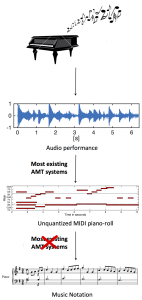Polyphonic Piano Transcription
Using a note based music language model can improve transcription performance. Notes are detected using a neural network architecture, which models the temporal evolution of note states. The onset of notes is the easiest frame to identify. Detecting notes at the onset reduces the accumulation of errors. However, this method has limitations, such as predicting notes at false negative onsets, which can lead to blank onsets in notations. For accurate note identification, notes with varying amplitude need to be detected. This problem is further complicated by note energy decay.
Several approaches have been proposed in the past to solve the problem of polyphonic piano music transcription. One approach uses a probabilistic latent component analysis (PLCA), which estimates the onset of notes. Another approach is to use a frame-based model to estimate notes. This approach superimposes the outputs of a frame-level acoustic model on the outputs of a frame-level classifier. However, previous frame-based prediction models treated each frame as an independent entity. This approach is not suited for the complex interaction of notes in music.

Note-based MLMs can better estimate high-dimensional temporal distributions. This approach has been used in audio transcription. For instance, Cogliati and Duan used a convolutional sparse coding model to model the evolution of piano notes. The outputs of the CNN are transformed by a sigmoid function. A softmax output is then predicted with a single loss function. These models can be trained with binary vectors sampled from MIDI ground truth. However, previous studies have focused on only one segment between successive onsets. This approach has not been tested on a polyphonic piano.
Polyphonic Piano Transcription With a Note Based Music Language Model
Another approach has been to use a dynamic Bayesian network to estimate the prior probabilities of note sequences. This approach uses a combination of a frame-level acoustic classifier and a recurrent neural network. The acoustic model is trained with isolated sounds from nine piano models from the MAPS database. Compared to previous methods, this approach has better performance. However, it requires an extensive search space. Currently, all existing MLMs are frame-based models.
Another approach uses a beam search algorithm to estimate notes, without using a note-based MLM. This algorithm is able to perform a global beam search and predict notes at non-blank onsets. It also achieves state-of-the-art results for common note scores.
In order to improve the performance of note-based MLMs, a new inference algorithm was proposed. This inference algorithm improves recall. However, this approach requires a high sample rate to perform well in music sequences. In addition, the proposed approach uses a single neural network architecture for both pitch estimation and note-based transcription. This approach can also be used to achieve polyphonic piano music transcription.
A software piano “StbgTGd2” was used for the evaluation of note-based MLMs. The results show that the proposed algorithm outperforms the thresholding method. In addition, the results are comparable to the results of the GBS algorithm. The F-measure is also high.
The present work has demonstrated that a note-based MLM can improve the performance of a polyphonic piano transcription system. However, a note-based MLM may not be able to model note transitions in music. Furthermore, the complexity of note interaction limits the performance of pitch estimation.